Abstract
Administration of insulin with glucose to starved lactating rats, which activates pyruvate dehydrogenase [M. A. Baxter & H. G. Coore (1978) Biochiem. J. 174, 553-561], restored lipogenesis in mammary gland in vivo to 50% of the value observed in refed (2.5 h) rats. The correlations between pyruvate dehydrogenase activity and the rate of lipogenesis persisted in isolated acini. Activation of pyruvate dehydrogenase in vitro with dichloroacetate increased lipogenesis from [6-14C]glucose in acini from starved and refed rats by 250% and 100% respectively. However, in the presence of dichloroacetate, only 70% of the increased flux through pyruvate dehydrogenase was converted into lipid in acini from starved rats, whereas all of the increase could be accounted for as lipid in acini from refed rats. Addition of insulin plus dichloroacetate was required to obtain maximal rates of lipogenesis in acini from starved rats. Similarly, insulin increased the incorporation of [1-14C]acetate into lipid only in acini from starved rats. Although the activity of pyruvate dehydrogenase plays an important role in the control of mammary-gland lipogenesis, the evidence presented suggests a second regulatory site which is insulin-sensitive and is located after the generation of cytosolic acetyl-CoA.
Full text
PDF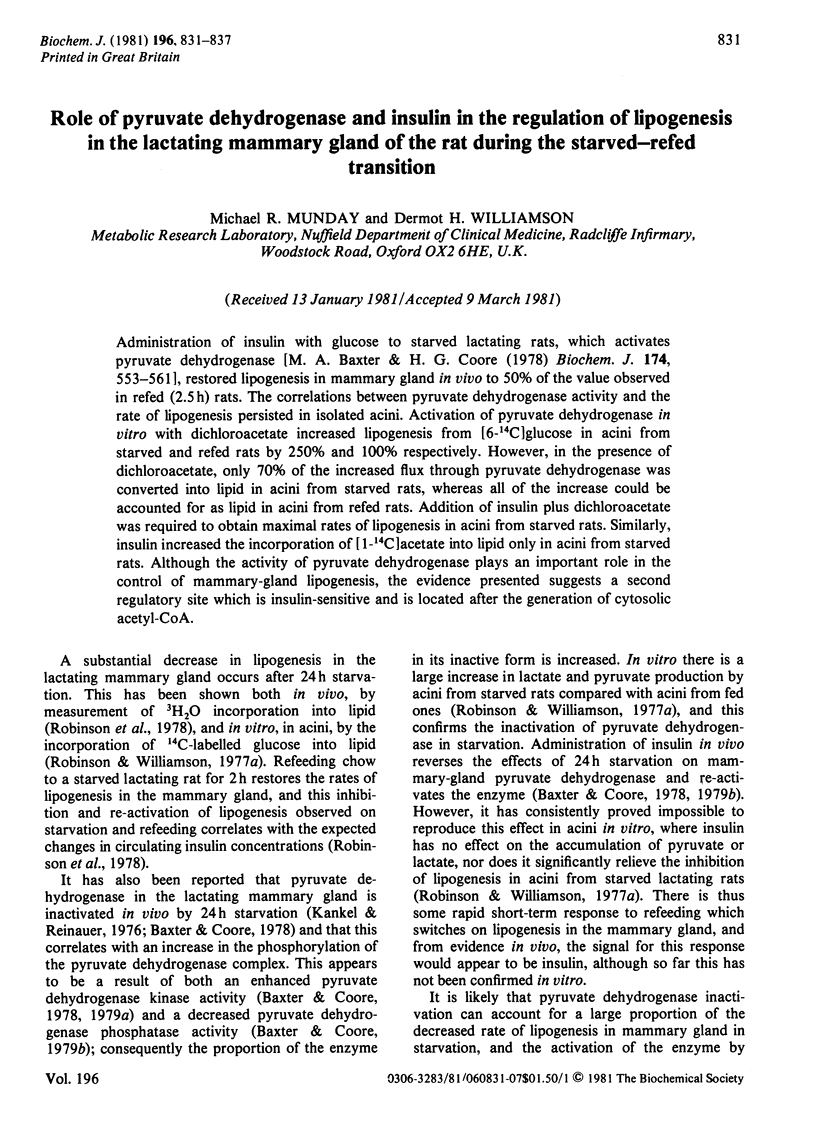

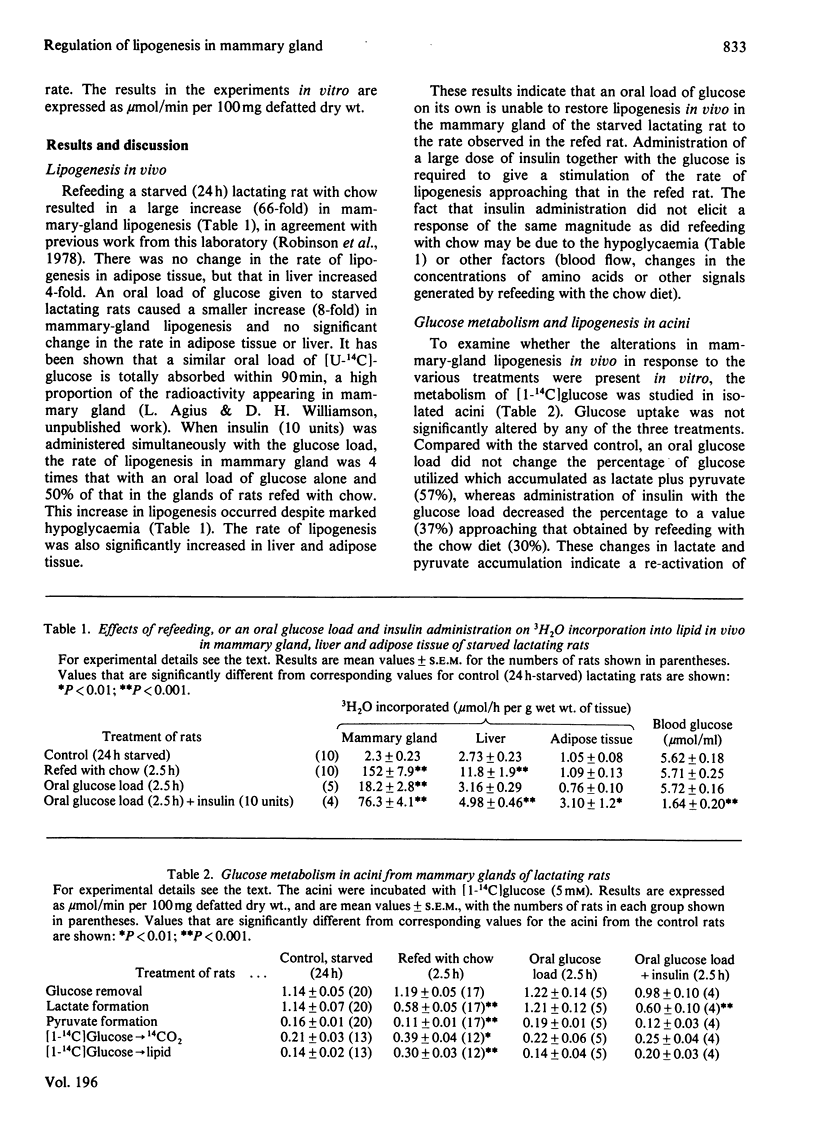
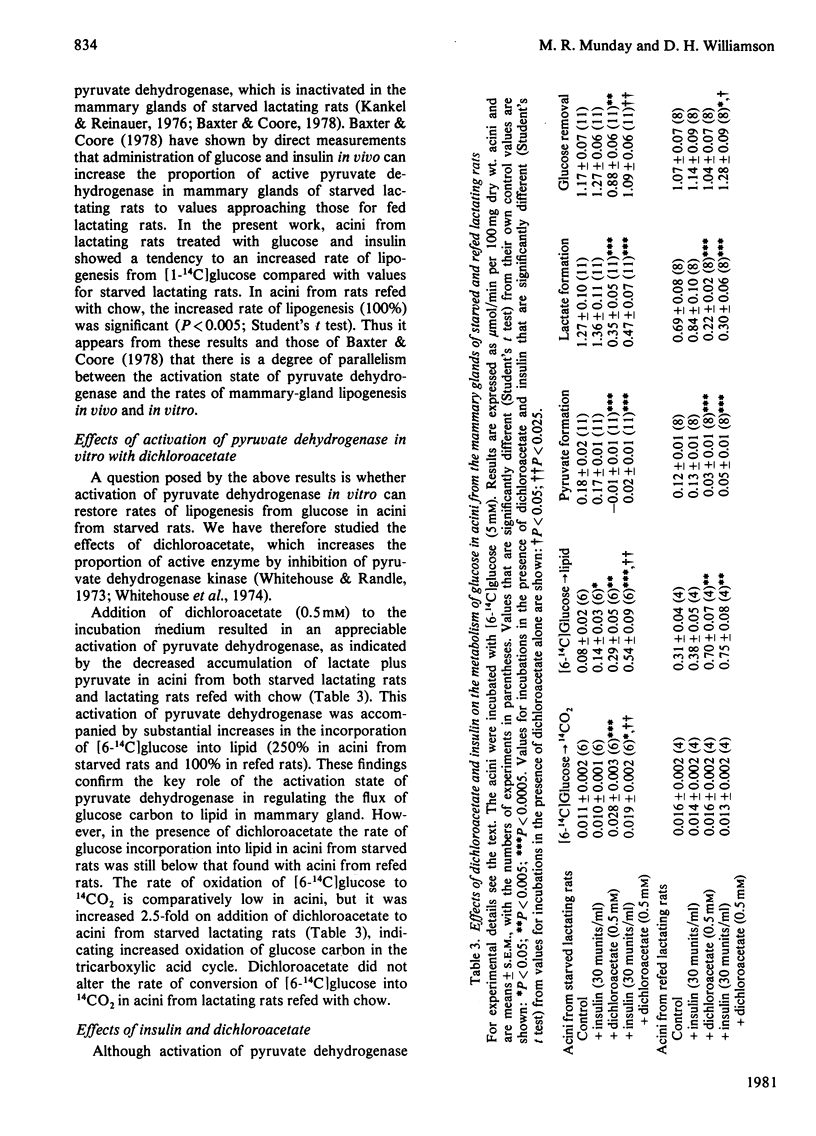
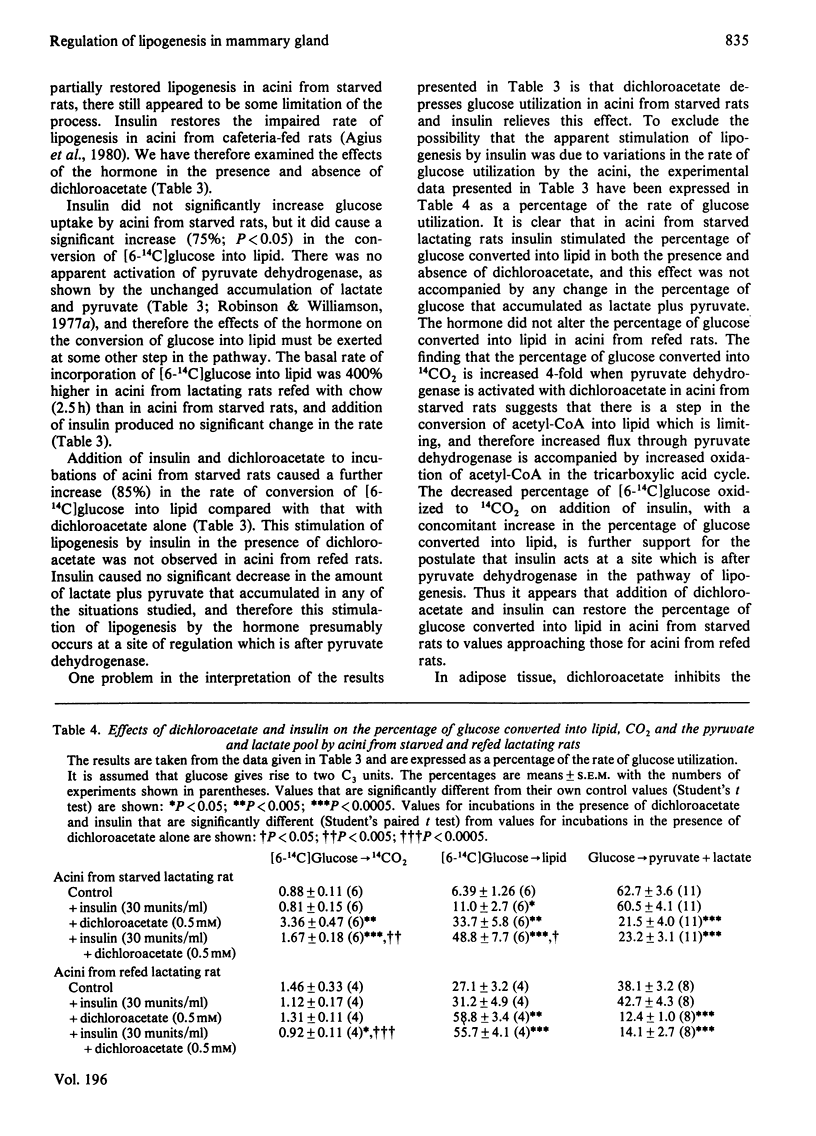
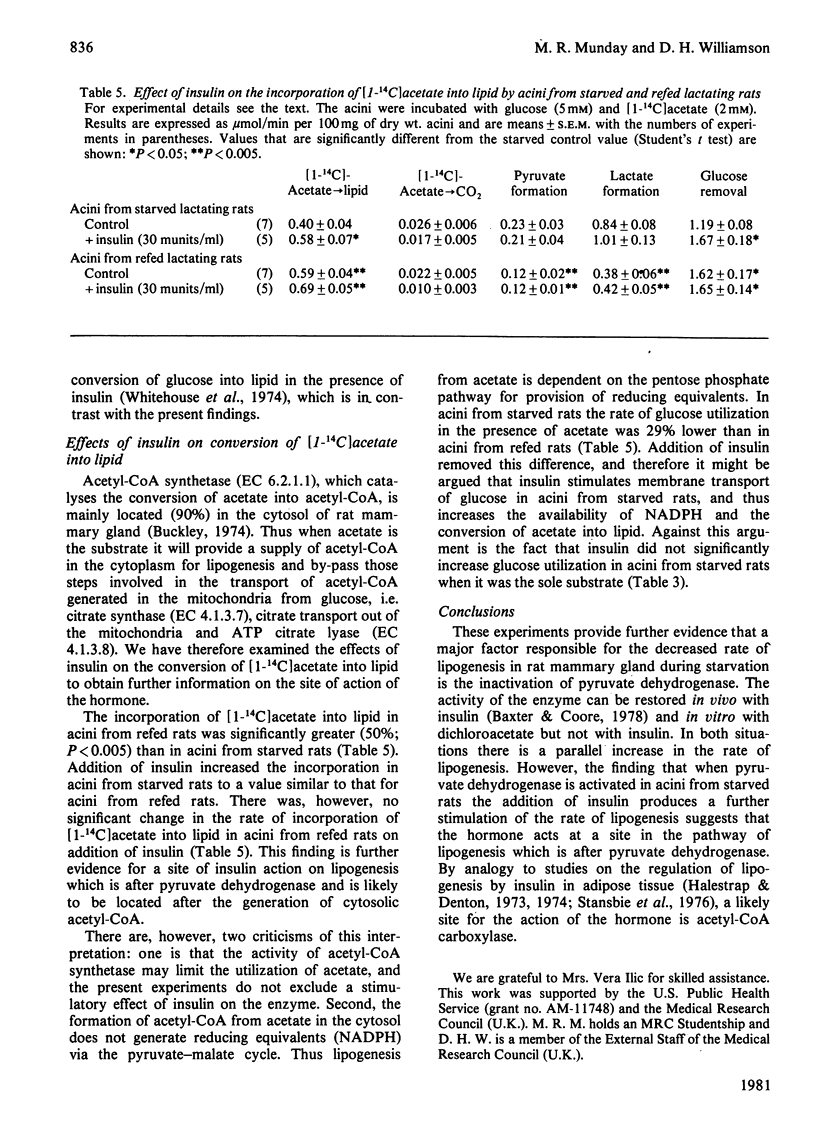
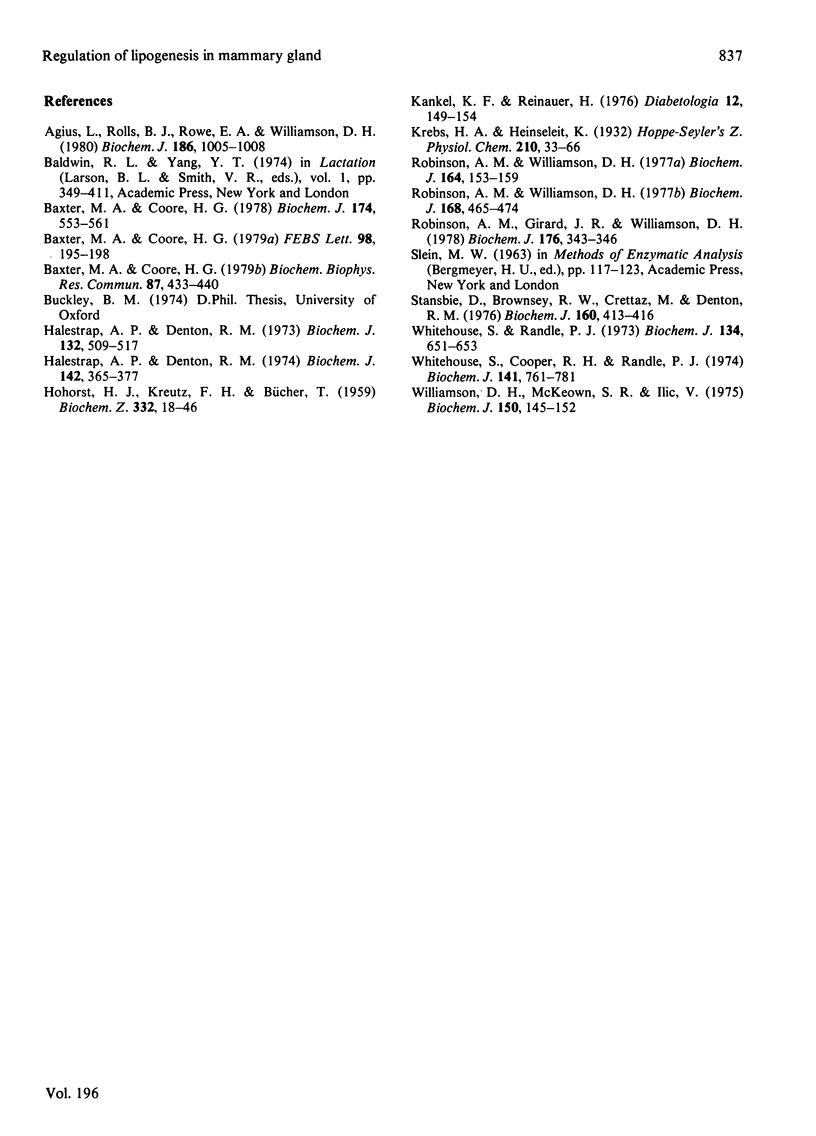
Selected References
These references are in PubMed. This may not be the complete list of references from this article.
- Agius L., Rolls B. J., Rowe E. A., Williamson D. H. Impaired lipogenesis in mammary glands of lactating rats fed on a cafeteria diet. Reversal of inhibition of glucose metabolism in vitro by insulin. Biochem J. 1980 Mar 15;186(3):1005–1008. doi: 10.1042/bj1861005. [DOI] [PMC free article] [PubMed] [Google Scholar]
- Baxter M. A., Coore H. G. Reduction of mitochondrial pyruvate dehydrogenase phosphatase activity in lactating rat mammary gland following starvation or insulin deprivation. Biochem Biophys Res Commun. 1979 Mar 30;87(2):433–440. doi: 10.1016/0006-291x(79)91814-x. [DOI] [PubMed] [Google Scholar]
- Baxter M. A., Coore H. G. Starvation of lactating rats leads to alterations in the behaviour of pyruvate dehydrogenase kinase which persist in the semi-purified pyruvate dehydrogenase complex of the mammary gland but are partly reversible in vitro. FEBS Lett. 1979 Feb 1;98(1):195–198. doi: 10.1016/0014-5793(79)80182-9. [DOI] [PubMed] [Google Scholar]
- Baxter M. A., Coore H. G. The mode of regulation of pyruvate dehydrogenase of lactating rat mammary gland. Effects of starvation and insulin. Biochem J. 1978 Aug 15;174(2):553–561. doi: 10.1042/bj1740553. [DOI] [PMC free article] [PubMed] [Google Scholar]
- HOHORST H. J., KREUTZ F. H., BUECHER T. [On the metabolite content and the metabolite concentration in the liver of the rat]. Biochem Z. 1959;332:18–46. [PubMed] [Google Scholar]
- Halestrap A. P., Denton R. M. Hormonal regulation of adipose-tissue acetyl-Coenzyme A carboxylase by changes in the polymeric state of the enzyme. The role of long-chain fatty acyl-Coenzyme A thioesters and citrate. Biochem J. 1974 Aug;142(2):365–377. doi: 10.1042/bj1420365. [DOI] [PMC free article] [PubMed] [Google Scholar]
- Halestrap A. P., Denton R. M. Insulin and the regulation of adipose tissue acetyl-coenzyme A carboxylase. Biochem J. 1973 Mar;132(3):509–517. doi: 10.1042/bj1320509. [DOI] [PMC free article] [PubMed] [Google Scholar]
- Kankel K. F., Reinauer H. Activity of pyruvate dehydrogenase complex in the mammary gland of normal and diabetic rats. Diabetologia. 1976 May;12(2):149–154. doi: 10.1007/BF00428981. [DOI] [PubMed] [Google Scholar]
- Robinson A. M., Girard J. R., Williamson D. H. Evidence for a role of insulin in the regulation of lipogenesis in lactating rat mammary gland. Measurements of lipogenesis in vivo and plasma hormone concentrations in response to starvation and refeeding. Biochem J. 1978 Oct 15;176(1):343–346. doi: 10.1042/bj1760343. [DOI] [PMC free article] [PubMed] [Google Scholar]
- Robinson A. M., Williamson D. H. Comparison of glucose metabolism in the lactating mammary gland of the rat in vivo and in vitro. Effects of starvation, prolactin or insulin deficiency. Biochem J. 1977 Apr 15;164(1):153–159. doi: 10.1042/bj1640153. [DOI] [PMC free article] [PubMed] [Google Scholar]
- Robinson A. M., Williamson D. H. Control of glucose metabolism in isolated acini of the lactating mammary gland of the rat. The ability of glycerol to mimic some of the effects of insulin. Biochem J. 1977 Dec 15;168(3):465–474. doi: 10.1042/bj1680465. [DOI] [PMC free article] [PubMed] [Google Scholar]
- Stansbie D., Brownsey R. W., Crettaz M., Denton R. M. Acute effects in vivo of anti-insulin serum on rates of fatty acid synthesis and activities of acetyl-coenzyme A carboxylase and pyruvate dehydrogenase in liver and epididymal adipose tissue of fed rats. Biochem J. 1976 Nov 15;160(2):413–416. doi: 10.1042/bj1600413. [DOI] [PMC free article] [PubMed] [Google Scholar]
- Whitehouse S., Cooper R. H., Randle P. J. Mechanism of activation of pyruvate dehydrogenase by dichloroacetate and other halogenated carboxylic acids. Biochem J. 1974 Sep;141(3):761–774. doi: 10.1042/bj1410761. [DOI] [PMC free article] [PubMed] [Google Scholar]
- Whitehouse S., Randle P. J. Activation of pyruvate dehydrogenase in perfused rat heart by dichloroacetate (Short Communication). Biochem J. 1973 Jun;134(2):651–653. doi: 10.1042/bj1340651. [DOI] [PMC free article] [PubMed] [Google Scholar]
- Williamson D. H., McKeown S. R., Ilic V. Interactions of glucose, acetoacetate and insulin in mammary-gland slices of lactating rats. Biochem J. 1975 Aug;150(2):145–152. doi: 10.1042/bj1500145. [DOI] [PMC free article] [PubMed] [Google Scholar]


